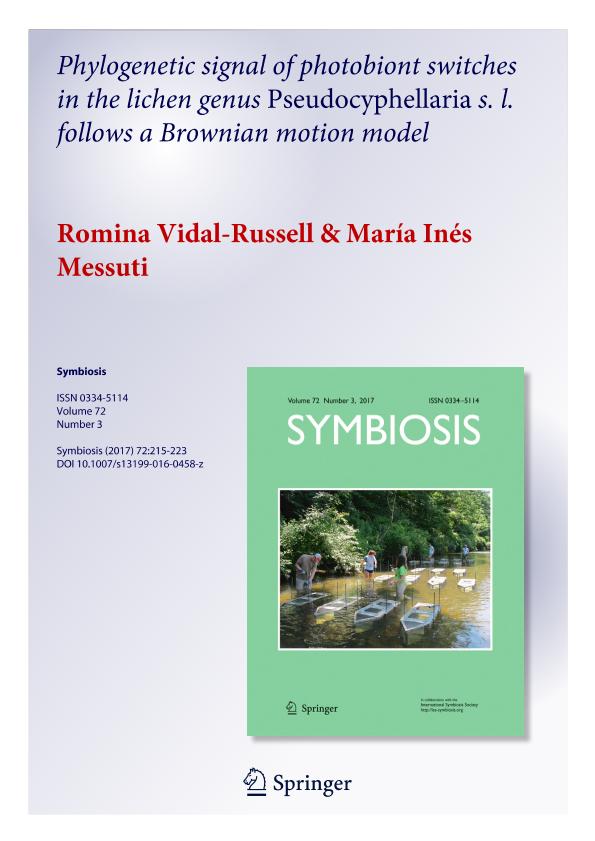Mostrar el registro sencillo del ítem
dc.contributor.author
Vidal Russell, Romina

dc.contributor.author
Messuti, Maria Ines

dc.date.available
2018-11-13T18:48:22Z
dc.date.issued
2017-06
dc.identifier.citation
Vidal Russell, Romina; Messuti, Maria Ines; Phylogenetic signal of photobiont switches in the lichen genus Pseudocyphellaria s. l. follows a Brownian motion model; Springer; Symbiosis; 72; 3; 6-2017; 215-223
dc.identifier.issn
0334-5114
dc.identifier.uri
http://hdl.handle.net/11336/64373
dc.description.abstract
Lichen symbioses are defined as a symbiotic relationship between a mycobiont (generally an ascomycete) and one or more photobionts (green algae or/and cyanobacteria). It was proposed that cephalodia emancipation is an evolutionary driver for photobiont switch from chlorophyte to cyanobacteria. In this study we want to test the monophyly of cyanolichens and to measure the phylogenetic signal of the symbiotic relationship between cyanobacteria and a mycobiont partner in the lichen genus Pseudocyphellaria. This genus includes some species that have a chlorophyte as primary photobiont (and Nostoc in internal cephalodia), while others have only cyanobacteria. In a phylogenetic framework we measure the phylogenetic signal (or phylogenetic dispersion) as well as mapped photobiont switches performing stochastic character mapping. Results show that having cyanobacteria as main photobiont has a strong phylogenetic signal that follows a Brownian motion model. Seven clades in the phylogeny had an ancestor with cyanobacteria. Reversal to a green algae photobiont is rare. Several switches were estimated through evolutionary time suggesting that there was some flexibility in these traits along the phylogeny; however, close relatives retained cyanobacteria as main photobiont throughout the cyanolichen’s history. Photobiont switches from green algae to cyanobacteria might enhance ecotypical differentiation. These ecotypes could lead to several speciation events in the new lineage resulting in the phylogenetic signal found in this study. We give insights into the origin of lichen diversity exploring the photobiont switch in a phylogenetic context in Pseudocyphellaria s. l. as a model genus.
dc.format
application/pdf
dc.language.iso
eng
dc.publisher
Springer

dc.rights
info:eu-repo/semantics/openAccess
dc.rights.uri
https://creativecommons.org/licenses/by-nc-sa/2.5/ar/
dc.subject
Evolutionary Driver
dc.subject
Lichenized Fungi
dc.subject
Photobiont Switch
dc.subject
Speciation
dc.subject
Symbiosis
dc.subject.classification
Otras Ciencias Biológicas

dc.subject.classification
Ciencias Biológicas

dc.subject.classification
CIENCIAS NATURALES Y EXACTAS

dc.title
Phylogenetic signal of photobiont switches in the lichen genus Pseudocyphellaria s. l. follows a Brownian motion model
dc.type
info:eu-repo/semantics/article
dc.type
info:ar-repo/semantics/artículo
dc.type
info:eu-repo/semantics/publishedVersion
dc.date.updated
2018-10-23T16:18:04Z
dc.identifier.eissn
1878-7665
dc.journal.volume
72
dc.journal.number
3
dc.journal.pagination
215-223
dc.journal.pais
Alemania

dc.journal.ciudad
Berlin
dc.description.fil
Fil: Vidal Russell, Romina. Consejo Nacional de Investigaciones Científicas y Técnicas. Centro Científico Tecnológico Conicet - Patagonia Norte. Instituto de Investigaciones en Biodiversidad y Medioambiente. Universidad Nacional del Comahue. Centro Regional Universidad Bariloche. Instituto de Investigaciones en Biodiversidad y Medioambiente; Argentina
dc.description.fil
Fil: Messuti, Maria Ines. Consejo Nacional de Investigaciones Científicas y Técnicas. Centro Científico Tecnológico Conicet - Patagonia Norte. Instituto de Investigaciones en Biodiversidad y Medioambiente. Universidad Nacional del Comahue. Centro Regional Universidad Bariloche. Instituto de Investigaciones en Biodiversidad y Medioambiente; Argentina
dc.journal.title
Symbiosis

dc.relation.alternativeid
info:eu-repo/semantics/altIdentifier/doi/http://dx.doi.org/10.1007/s13199-016-0458-z
dc.relation.alternativeid
info:eu-repo/semantics/altIdentifier/url/https://link.springer.com/article/10.1007%2Fs13199-016-0458-z
Archivos asociados
